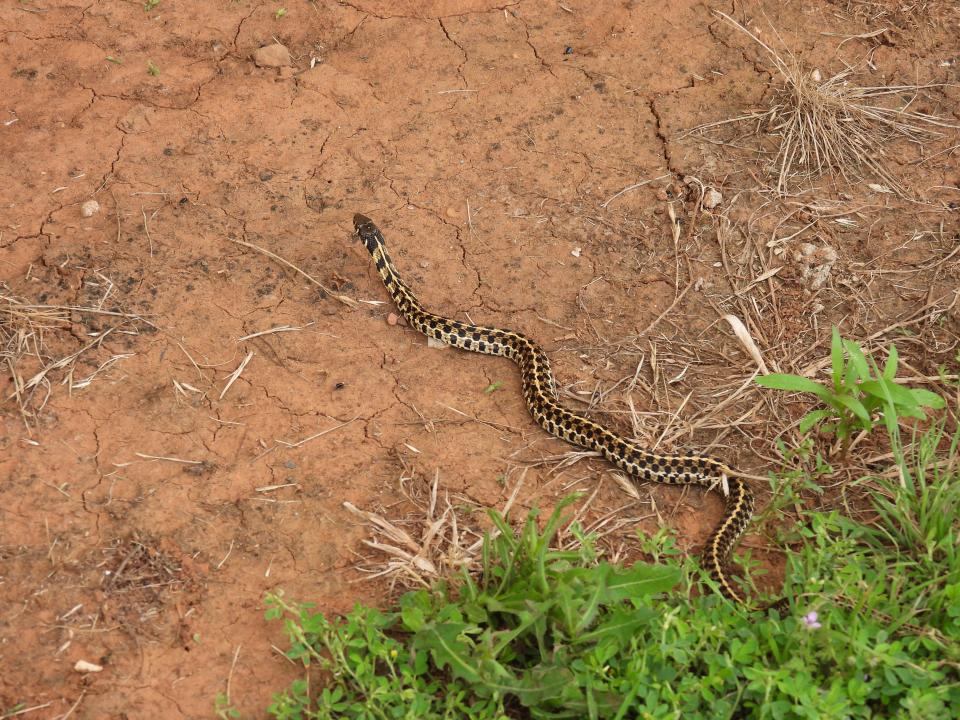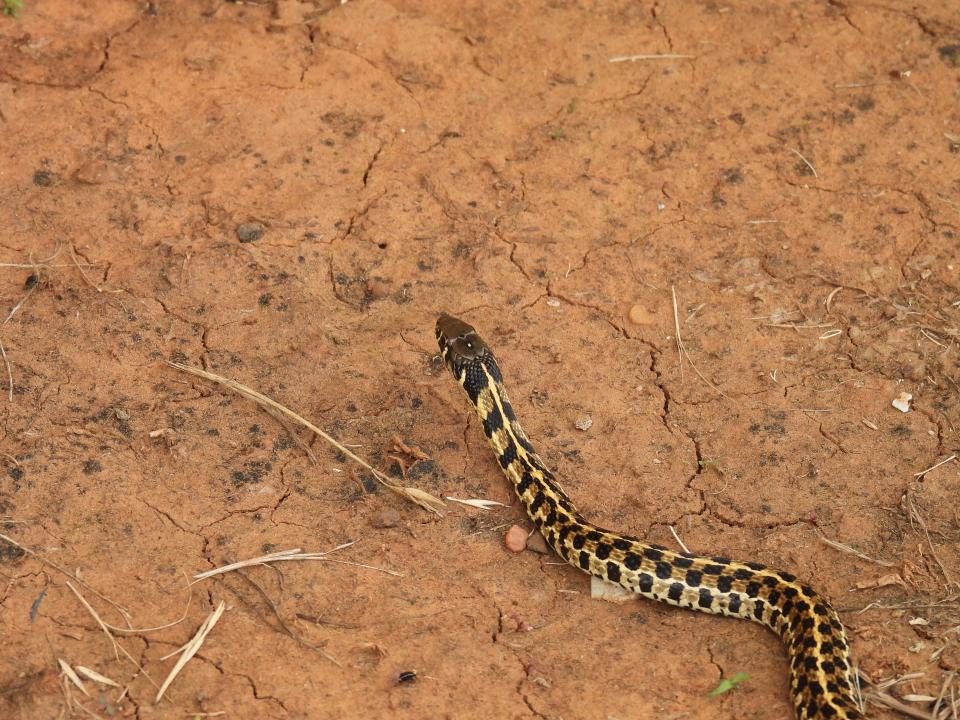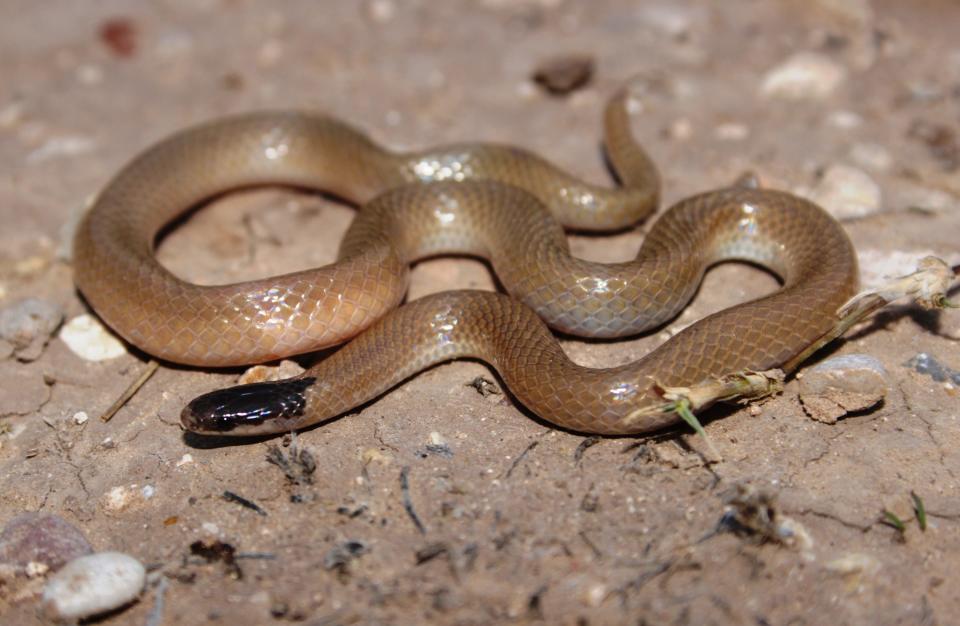Some Diverse, Not Deadly, Snakes Around Farms and Homes
To continue a previous theme on snakes, I’ll present some additional common, non-venomous (or at least not harmful to humans) species from the area. These snakes come in a variety of sizes, colors, and patterns and are found in diverse habitats in the north-central Texas and southwestern Oklahoma region.
(Area snakes are found in many colors, patterns, and habitats)
To continue a previous theme on snakes, I’ll present some additional common, non-venomous (or at least not harmful to humans) species from the area. These snakes come in a variety of sizes, colors, and patterns and are found in diverse habitats in the north-central Texas and southwestern Oklahoma region.
One of the most common snakes found in backyard and garden areas is the Checkered Garter Snake. This versatile snake is well-suited to drier areas in our region and inhabits grasslands and mesquite pastures away from permanent water sources as-well-as stream and river edges and irrigation ditches in our area. Its colors vary from yellowish to gray; but the most common base color is a light tan with a darker-crowned head. Two black-edged, whitish to yellow dots are found near the center of the snake’s crown. Garter Snakes have a pattern of three light-colored lines (one in the middle of their back and another on each side) extending from neck to tail. True to its name, the Checkered Garter Snake has a bold, checkerboard pattern on its back and sides from neck to tail! These snakes are not exceptionally large with adults averaging approximately two feet in length.

The Checkered Garter Snake has a varied diet. Prey items range from earthworms and insects to small fishes, amphibians, and mice! Checkered Garter Snakes are most active during morning and late afternoon hours in spring and fall, but switch to nocturnal hours during summer months when area temperatures become too hot. Interestingly, it was recently discovered that Garter Snakes produce venom that helps them subdue and digest prey items but, except in rare cases, this venom does not harm humans. Unlike many other species of snakes, Checkered Garter Snakes are ovoviviparous and, instead of laying eggs, give birth to live young after a period of internal gestation (= pregnancy). Checkered Garter Snakes quickly adapt to captivity and are commonly found in the pet trade.

A second, even smaller, area snake found in our yards, gardens, flowerbeds, underneath rocks and in leaf litter is the Plains Black-headed Snake. Other habitats where the Plains Black-headed Snake resides are similar to those of the Checkered Garter Snake and usually include at least small amounts of moisture and/or water. This small snake averages only seven to 10 inches in length and has a distinctive, black-capped head that contrasts with its otherwise pale, pinkish body and light-colored belly. The Plains Black-headed Snake’s food consists of arthropods such as spiders, scorpions, centipedes, crickets and insect larvae. Also, (similar to the Checkered Garter Snake) the Plains Black-headed snake produces venom that is harmless to humans but effective upon its arthropod prey! Some authors refer to these snakes as ‘rear-fanged’ but it is doubtful that the tiny Plains Black-headed Snake could successfully bite most humans!

A "not-so-small" and sometimes more fearless snake encountered by fishermen in our streams, rivers, lakes and ponds is the Diamond-backed Water Snake. This heavy-bodied serpent ranges from two to four feet in length and usually has an overall light-to-dark brown body color. A series of dark, X-shaped bars extends along its back with dark lateral bars on its sides. This pattern is described as resembling a chain-linked fence. The belly of the Diamond-backed Water Snake is a yellow-to-orange color and a series of distinct, small, dark lines extends down its yellowish lip scales. The head is large, somewhat flattened, and wider than the neck. Older individuals may be darker colored and have less distinct body patterns.
The non-venomous Diamond-backed Water Snake is sometimes mistaken for the less common (and venomous) Cottonmouth or Water Moccasin. However, the Cottonmouth has a heat-sensing pit located between its eyes and nostrils, elliptical pupils (as opposed to round pupils of the Diamond-backed Water Snake), and a wide, flat and angular (wedge-shaped) head. Additionally, the two snakes swim differently. The Diamond-backed Water Snake swims almost completely submerged in the water with its head just above the surface; whereas, the Cottonmouth swims with its body on the surface of the water and its head elevated well-above the water.
Food items of the Diamond-backed Water Snake include fishes, frogs, tadpoles, toads, baby turtles and minnows. Water Snakes are more active during nighttime hours but, if temperatures permit, also forage during the day. The snakes usually employ a patient ‘sit and wait’ hunting style at the shallows of lakes and ponds, swampy areas, and the quiet, still eddies of streams and rivers. If disturbed or startled, the Diamond-backed Water Snake will flatten its head and body and open its mouth in a startle display to bluff the potential threat (another reason they are often mistaken for Cottonmouths). If this tactic doesn’t work, the snake will often move aggressively in the direction of the threat; at least for a short distance! Perhaps because they spend much time in the water, Diamond-backed Water Snakes are ovoviviparous and (similar to the previously-mentioned Checkered Garter Snake) give birth to live young.
A final large-sized, uniformly-colored, resident snake commonly occurring in open, grassy areas, sandy regions, and rocky habitats is the Western Coachwhip. These excellent hunters are capable of moving at high speeds to hunt and capture prey and they are also good climbers! Coachwhips are mostly uniform in color; but a great range of colors (from gray to a bright, brick-red) is found in the species. The most typical color of the Western Coachwhip is a light tan to brown. The Coachwhip’s common name comes from the braided appearance of its body scales; which give it a whip-like look. The Western Coachwhip is one of our largest area snakes with many adults attaining lengths of five to six feet. Coachwhips have large eyes and excellent vision. They are often seen traveling and searching through areas with their heads positioned well above grasses and other vegetation for a better look at prey or threats. These snakes are effective ambush hunters and, with their long and slender bodies, readily follow prey animals into crevices and burrows in order to capture a meal! Hunting usually occurs during the day (often in the hotter, afternoon hours) and prey consists of small mammals, lizards, skinks, insects, birds and bird’s eggs and occasionally other snakes. It has been reported that Coachwhips are aggressive snakes and will chase humans; but, I have never personally experienced this. All the Western Coachwhips that I have encountered were moving away from me as rapidly as possible!
If you happen to see any of these non-venomous snakes in our area, remember that, from the small Plains Black-headed Snake to the large Western Coachwhip and Diamond-backed Water Snake, they perform essential services for the environment and us. They pose no threat and are usually quite willing to rapidly retreat from our presence. So much so, in fact, that many of us feel quite lucky to briefly encounter these snakes in their natural environments!
This article originally appeared on Wichita Falls Times Record News: Some Diverse, But Not Deadly, Snakes Around Farms and Homes

